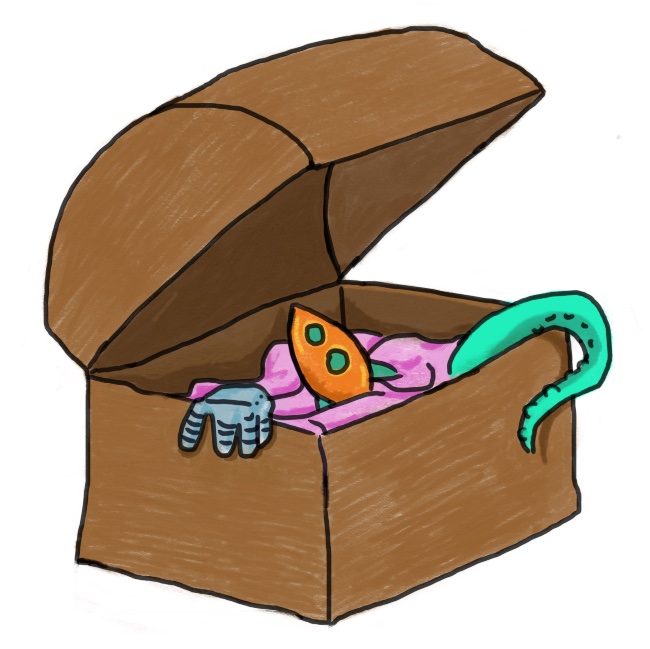Vera asked me to show how I change a story from one draft to another, so she could see clearly what happens. The concrete, bones-and-sinew workings!
Bad news: I do not save drafts. I edit in the same file, deleting willy-nilly until the story sells.
Good news: I belong to a writer’s workshop and got one of the members to send me my most recent story draft I had them critique! Better yet, it’s a flash piece, so the comparison output was not terribly long.
Come, join me on an adventure through “Iron Priest.” (Spoilers ahead for the story, which is live now on Daily Science Fiction, if you want to go there and read it first.)
I wrote the first draft of this back in my first write-a-thon in 2012. Obviously, as said above, I don’t have it anymore, but I recall it was about 75% of the final story. I wrote the draft, went on to the next thing, and forgot about it. At the time I thought it wasn’t good enough to make into a saleable story. It was a robot priest asking another robot to confess its sins so it could be shriven before being recycled for parts. Dark, but really just a scene. It didn’t have an ending.
Then, last year, I was looking through my old write-a-thon drafts for something worth revising and I read it. “By Gort, this thing isn’t half-bad, actually. It just needs an ending.”
I wrote an ending for it that seemed simplest… the robot refuses to confess and is dismantled anyway.
I put it away and forgot about it, then found it again and thought, “It’s just missing a twist so it can feel like it has structure. Right now it’s a straight line.”
So I added a pause, a bit of introspection to the priest-bot that made the ending action seem more startling and abrupt, and feeling it was finally “done,” sent the story to my writer’s workshop. It was a real short-short, 600 words long.
Here are some of the comments. (I keep detailed notes during critique, so these are straight from that document, anonymized because my workshop-mates may not appreciate being quoted out of context.):
Hamster1: Be consistent whether you use “he” or “it” — I had to look up “shriven” Maybe add explainer? What are the ethical considerations? Are they actually absolved?
Hamster2: Why Catholicism? Why that moral system?
Hamster1: Robots have too many rules not to be Catholic.
(laughter)
Hamster2: I wanted more oomph to the end. More difference between the robots. The “closed a connection designed for it” part confused me.
Hamster3: Like a lot of things in Daily Science Fiction, if you think a minute, you end up saying “what?” Does the Iron Priest have a soul? Is he worse than Hitler? How do they get souls? Why did humanity give souls to killer robots? Questions!!” The convert had not the ability to interpret language — so you’re teaching him language?
[I noted — I like that these questions are going through her mind. Language is an easy fix. – it’s about the ability to understand the emotion behind the language.]Hamster4: rather than make the fact that they are killbots a surprise, say it up front? On page 2 – garbage data spilled into the connection – I get intellectually what that means but I don’t get it emotionally. The last line suggests a certain loss of faith from the priest bot. Show or explore a little bit more, earlier on?
Hamster5: Weave in the morality of the society that built these robots. Up the stakes on not being shriven. {my note: “Hell.”}
Hamster6: I got that they were killbots from the beginning because why else would they need forgiveness? It’s enough of a twist for me. Like the first and last lines. Send it to F&SF.
Hasmster7: More physical details. Head? Torso? Arms? “Convert” bothered me. “Supplicant” Makes more sense in context. Also, there is no sin without consciousness. This robot is not damned until it is aware.
Hamster8: Ignore everyone. It’s perfect, send it to Asimov’s. It’s Asimovs-y. (Yeah this doesn’t happen often in workshop. :D)
… OK So, after writing down everything my workshop-mates said (I shortened their input here to the most relevant/representational parts), I wrote the following plan to change the story. (I do this right in my notes document, at the end. Actually, I write my action-items as I go, dropping down to edit as I change my mind while people are talking.)
The plan:
1. Cut didn’t understand language – didn’t understand EMOTION
2. Tell is killbot right away. Know his number, btw.
3. Mention threat of hell, eternal hell. OMG.
4. Choice? Is it still a sin without choice?
5. If there is no conscious, the sin belongs to the master who made it.
6. “suplicant” is better title than “convert”
I took a week or so off from the story so that it would feel fresh when I edited it. Among other things, I hadn’t expected everyone to react to this as a Catholic story, which was a bias inside of me, my own early indoctrination in that faith. I had thought I was being generically religious. Well, there was no way out of it so I committed my soul to writing Catholic Robots. Then I opened my story draft and opened my workshop notes document next to it, skimmed down to my plan list and started going through the numbers.
- Cut didn’t understand language.
The convert had not had the ability, before now, to interpret the language spokenemotion behind the words.
In my first draft, I’d said the robot couldn’t understand the language spoken – which lead the reader away from the meat of the story and into the idea of languages and why did the robot not understand, say, English? I hadn’t meant it that way in my head, changing the focus to the emotion kept things on track.
2. Tell is Killbot right away
Easy, I just added this to the bottom of the first paragraph:
A killbot, from series 7c, number 644.
Now people wouldn’t be asking what the supplicant’s role in life had been, why it was so upset. You can fill in a lot of backstory with the simple word “Killbot.”
3. Mention Hell
I added this line of dialog:
"Burn in Hell."
This solidifies the Catholicism and gives both robots a little bit more stake in the game. They believe in a hell, they don’t want to go there.
4. Choice. Is it a sin without choice?
5. If there is no conscious, the sin belongs to the master
These are really the same thing, and I added an extra clause onto a sentence to insert this thought:
... his own conscience the day he realized the makers would bear the sins themselves, if their servants had no moral choice.
6. “Supplicant” is better than “Convert”
Easy edit. I just went through and replaced the word “Convert” to “Supplicant” wherever I referred to the robot being asked to confess his sins.
After I did that, I read over each of the workshopper’s line-edits they’d sent me. Everyone in my workshop gives their copy of the story back to the author at the end of the critique, either printed out and marked up with pen, or electronically using Word’s comments feature or Track Changes.
I shuffle my buddies into a pile based on who I think had the most relevant-to-this-story critique first. If it’s a hard SF story, for example, I always go through the physicist’s critique first. If it’s one of my fantasies, the fantasy-writer goes first. Sometimes I just know a particular person “got” the story best, and there’s always one person who didn’t get the story at all and I shuffle that poor soul to the bottom, knowing all they can offer are typo-catches. (The edits I make for the others will, I hope, make the story clearer so that said person would have gotten it. Also note, this is a different person every time. Sometimes it’s about the type of story — like that physicist might not “get” the fantasy and end up on the bottom of the pile because all his comments about how the gravity should be working are actually irrelevant.)
OK, so, I toss out the line-edit drafts as I finish editing to them. It’s a very satisfying feeling. Physical evidence of accomplishment. But I can’t go back and find what they said. However, I can look at the differences between the version I sent out and the version I had published and guess what caused me to change things.
A line about closing a circuit confused one reader so I changed it:
His metal finger closed a circuit designed just for it. The convertwith a gap precisely the width of that finger.
A few workshoppers mentioned wanting to have more of a visual idea of what the robots looked like, so I added a few descriptions. I had pictured them basically human-shaped but boxy and metal.
Its eyes re-focused. It had a stylized face, chrome long gone grubby with age.
Here’s a paragraph I changed a bit in response to inline comments (why?) and (keep pronouns consistent) the “the” I cut for my own reasons as I read:
This convertkillbot was designed to analyze motions and sounds to weed out intelligent life from unintelligent. so that animals could be spared. When the targets pleaded for mercy, it was a pleasing confirmation that heit had judged correctly.
Two people didn’t know what the word “Shriven” meant so I added an explainer.
And … that’s pretty much everything I changed. My revised story was just 90 words longer, and most of my revisions were adding words.
Caveat: This was a remarkably light critique. I’ve gotten much more things to fix on stories just as short. Sorry, it’s just the one I had two drafts to compare!
Another Caveat: I want to make it clear that I didn’t change something for every critique. Something hard for me, and I’m sure for most new writers. You want to fix every problem … but sometimes it’s just a problem for that person and you’d be customizing the story for an audience of one and potentially damaging it for the broader audience. If I kept more of the line edits I could have an example, but trust me, these days there’s always at least one edit I ignore.
You can read the entire story at Daily Science Fiction to see how it all comes together.
Despite one hamster (who has been in F&SF) telling me to send it there and another (who has been in Asimov’s) telling me to send it there, I sent it to Daily Science Fiction first, and they bought it, making the person who commented it was like “a lot of stories in Daily Science Fiction” prescient!


